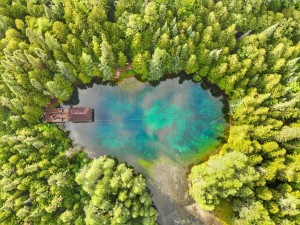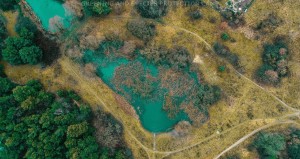Berlin, Germany Feb 26, 2021 (Issuewire.com) - Greening Deserts Critically Endangered Species Research and Protection Program (CES-RPP) started an extra project for endangered tree species to focus on the most important issue of global biodiversity conservation and establish more biodiversity in habitats and forests worldwide. This will also promote many other ecosystems, and stabilize as well as improve the atmosphere or air, biosphere, global climate, and the water cycle. The contribution of trees to the improvement of soil, life, air, and water quality should be clear to everyone. There is as much life in a handful of soil from a rainforest as in hundreds of soccer fields, but not so much in fields and meadows. It depends also on the history and vegetation. The main focus of the special species protection project for critically endangered tree species is the building of special seed storage facilities (boxes and cabinets) and other innovative solutions in various areas. The exchange and sharing of experiences are particularly important. With the Urban Greening Camp we can store and preserve seeds professionally. In the field of Indoor Gardening and Vertical Farming, we can cultivate many species of trees, especially for the European and Mediterranean regions. We can share seeds and plants with botanical gardens and professional nurseries around the world. Numerous international institutions, organizations, universities, biodiversity and plant scientists, and tree and forest specialists have already been informed about many of these aspects and projects in 2020.
This announcement and information on the new Greening Deserts project for critically endangered species can be shared worldwide. The project title is 1001+ Critically Endangered Tree Species Seed Storage and Tree Cultivation Project. The Trillion Trees Initiative will help to share the trees and seeds worldwide in the future, especially in regions where more biodiversity is needed or trees have become extinct or very rare. Some of the other Greening Desert projects and special programs can also help establish many of the endangered tree species on which many other species depend. This special biodiversity conservation, ecosystem restoration, environmental greening, ecological reforestation, and species protection projects can save millions of life forms worldwide. Healthy ecosystems like forests are habitats for countless organisms and can save many endangered insects, fungi, and microbes. That's why Greening Deserts species conservation projects will focus on biodiversity forests, drylands, grasslands, and wetlands. Urban greening and biodiversity in cities will be supported by the upcoming greening, research, and species protection camps.
Species conservationists, tree experts, botanists, tree growers, and all friends of nature are invited to join the project, for example by exchanging useful information or sharing constructive feedback and resources. Of course, other experts and scientists who are able to support the project can also join. Together with the CES-RPP, we can set a goal to recultivate and replant forests, typical tree landscapes, and regions with critically endangered tree species and key plant species worldwide. If we focus on cultivating and exchanging seedlings around the world, we can save many tree species from extinction. If all goes well, we can lift the critically endangered status of many trees and truly save them by cultivating plants and sharing seeds. Other important tasks are to show natural alternatives to pesticides and to promote nature-based solutions and permaculture.
Botanical gardens, nurseries, tree experts, forestry companies, and tree-related businesses should pay more attention to these factors. One big cause of biodiversity loss and mass mortality is deforestation and too many monocultures. This issue is not only about the few established tree species in forestry, it is also about many other important plants and keystone species. With the endangered tree species that we want to cultivate and share worldwide, thousands of other species can be saved and protected. These trees and plants may even bring back other species that were thought to be extinct. Biodiverse forests, meadows, and fields are the key to counteracting global species extinction on a large scale. Many of the critically endangered tree species play a particularly important role. On the pages of Greening Deserts and affiliated projects, you can read more about the real problems and good solutions in almost all areas, especially how to act in a truly efficient and sustainable way.
Environmental satellites, GIS systems, and satellite imagery of global vegetation can also help select the right trees for the right areas. Historical archives and plant databases can be used to find suitable tree species for those regions with low biodiversity, like in Europe and North Africa, where few tree species exist and many have been lost or forgotten—especially in relation to the approximately 60,000 tree species, of which about 10,000 are endangered and 1400 are critically endangered. That's why Greening Deserts has set the goal of saving the most endangered tree species while working together with interested species protection organizations, tree nurseries, botanical gardens, and institutions in this area. It is not only about biodiversity hotspots, new forests, and a few more tree species, but about many other plants, animals, and ecosystems that used to have greater biodiversity. Biodiversity in cities and urban regions is more important than many people think. Ecosystem and landscape experts can help to find good places for greening and reforestation, or even for completely new forests, such as in man-made deserts or urban concrete jungles. Urban greening and urban forests will play an increasingly important role over time, especially in relation to the issues of biodiversity, global greening, health, and the urban cooling aspect.
Some cities are now already up to four degrees hotter than in the old days, i.e. the 1.5 or 2-degree target has long been exceeded in some regions! Many people around the world have died as a result of the droughts and heat waves of recent years. The passive effects of the climate crisis, such as environmental or natural disasters and pandemics are underestimated, especially when it comes to poverty. Experts estimate that over 100 million people will fall into poverty during the actual crises. All the more reason why we need holistic solutions to the climate crisis and global solidarity with these poor, sick, and weak people. Healthy ecosystems and a healthy environment are the basis for the health of all life forms. Adapting to climate change and strengthening cultures is important not only for humans but for animal and plant species. Only together with nature, we can overcome the crisis. Nature-based solutions play an increasingly important role. One can see the Corona crisis as part of the climate crisis
Climate protection and environmental protection are also species protection—and therefore human protection. Species recovery, species conservation, and biodiversity with species protection camps and special protection programs like the Trillion Trees Initiative can reduce global species extinction with appropriate international support. The camps primarily serve to restore near-natural ecosystems. Global greening can accelerate the peace-building process and reduce climate change effects like global warming and air pollution. Environmental awareness, ethical and social principles, sustainable production and work, and human rights and indigenous rights are very important for future development. For years, we have been informing organizations and institutions about Greening Deserts projects. Requests for funding and support of these important developments and projects have been sent several times.
The global extinction of species, lack of biodiversity and species protection, or too little species rescue in many areas also increasingly affects human health. The current crisis and drought years have clearly shown everyone how quickly ecosystems can collapse or become unbalanced. The important role of missing tree species, especially in tree-poor regions of Europe and the Mediterranean, is greatly underestimated. Several hundred other species can depend on each individual tree species! Since many thousands of tree species are critically endangered and only rarely present, hundreds of thousands of species that depend on these trees are missing. This is one reason behind the extinction of numerous species. Trees fulfill important functions and are key elements of ecosystems and cycles. Climate and weather systems are also significantly influenced and stabilized by trees and forests, as well as all associated plants.
One unfortunately still hears many limited arguments or opinions in agriculture and forestry. Agroforestry, food forests, flowering trees, and more trees with fruits for animals and humans are possible to combine more sustainable agriculture and ecological forestry! AI, aquaponics, cleantech, hydroponics, Greentech, permaculture techniques, and vertical farming, scientific developments or achievements can also help improve all these areas or sectors. Many of the long-discussed conflicts are really unnecessary, especially the land use conflict. Think about all the space in the air, underground, underwater, and on waters. A lot of things are possible at the same time if one is creative, willing to compromise, and understanding. Often there is simply a lack of awareness and will. If all nations plant a few billion trees during the next years we could reach the goal of a trillion trees extra for planet Earth easily. If most of the humans plant a few hundred trees in their life the humanity could plant another trillion trees in just one generation – it could be so easy if all humans would act together. In the meanwhile, we will push the trillion trees initiatives with good actions, examples, and projects. Many people and organizations were informed about the Greening Deserts' sustainable developments, innovative ideas, and outstanding projects.
Here are some of the main projects: Afforestation.org, Artenschutzcamp, Desert Bamboo Africa, Ecosystem Restoration Network, Energy Storage Park, Greening Coasts, Greening Drones, Greenhouse Ship, Green Ring Africa, Great Green Wall North Africa, Hemp Papers, Recycling Ship, Reforestation Europe, Rice Straw Paper, Rooftop Greening, Seeding Balloon, Species Protection Europe, Transparent Solar, Trillion Trees Africa, Trillion Trees Foundation, Urban Greening Network,.. tbc.
The first Urban Greening Camp will be located in Leipzig, Germany. The state of Saxony is a relatively central region in Europe. Effective logistics, sustainable working, and sustainable packaging, as well as shipping, should not be a problem. The founder and initiator Oliver Gediminas Caplikas is working hard on the concepts and projects, at the moment he prepares a new location and the launch of a new startup. The startup project mainly deals with palms and palm products. More about the new project development in the next article and press release. Many interesting developments, information, and projects on the topics have been published in scientific networks and on various platforms during the last years. Read more on Greening Deserts' official project pages.
Media Contact
Oliver Caplikas welcome@greeningdeserts.com http://www.greeningdeserts.com/












